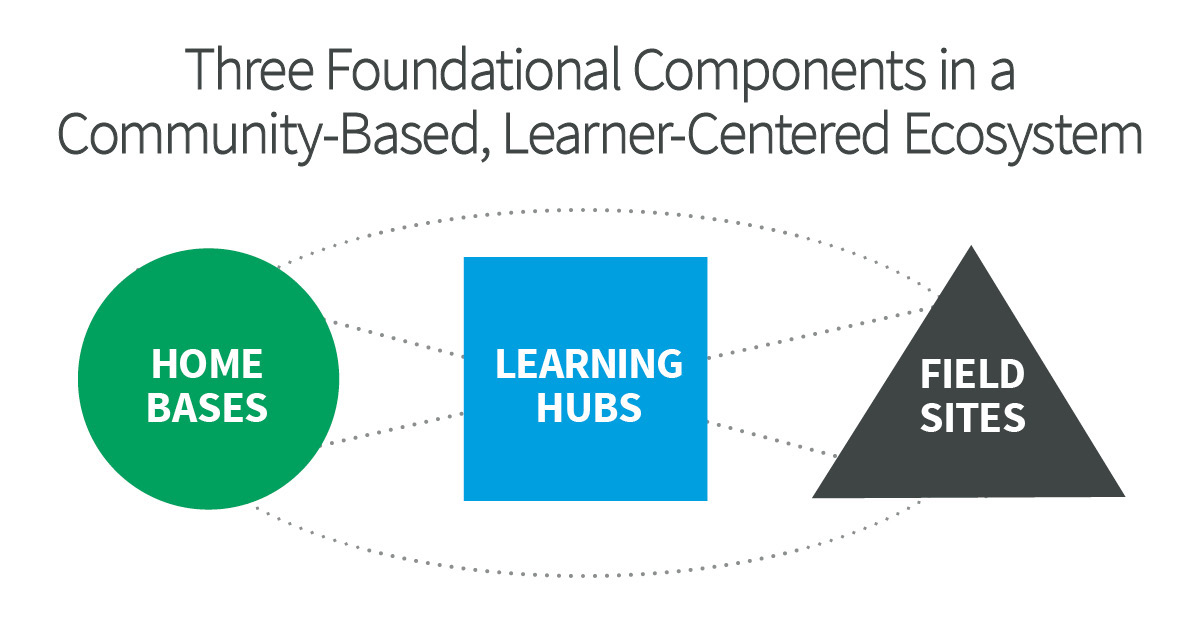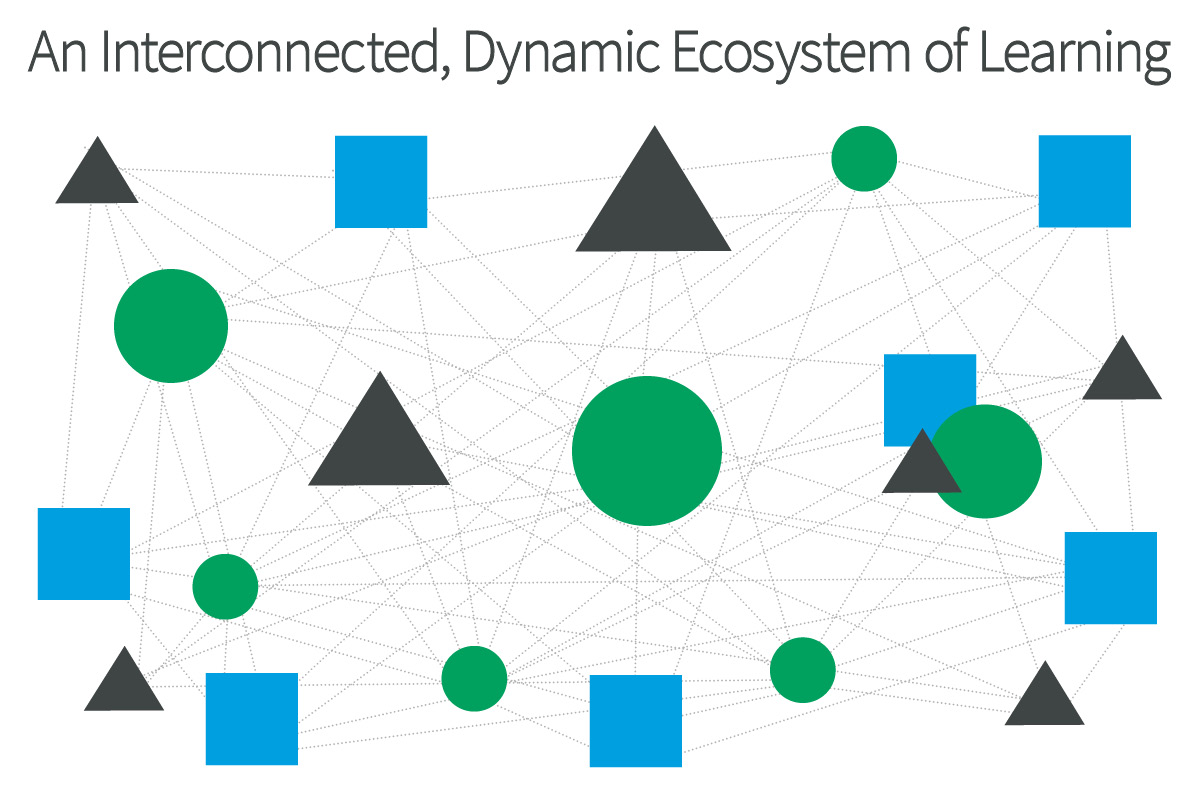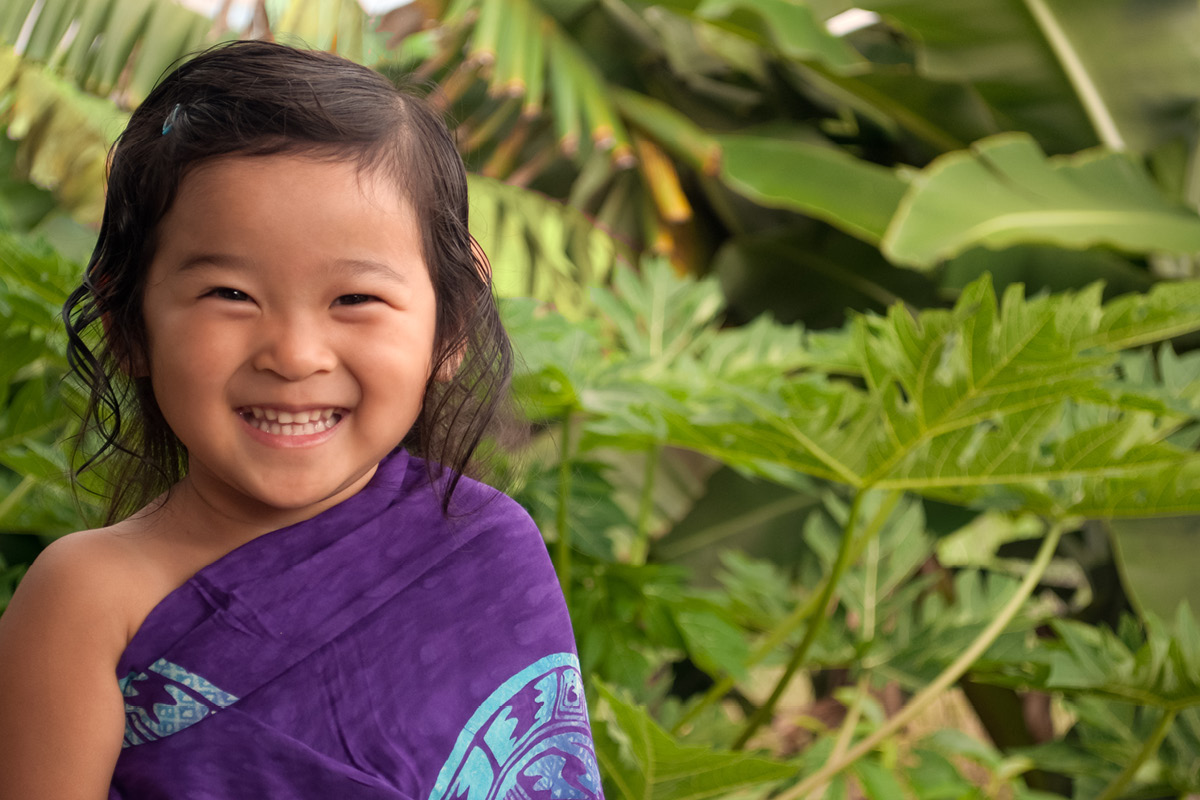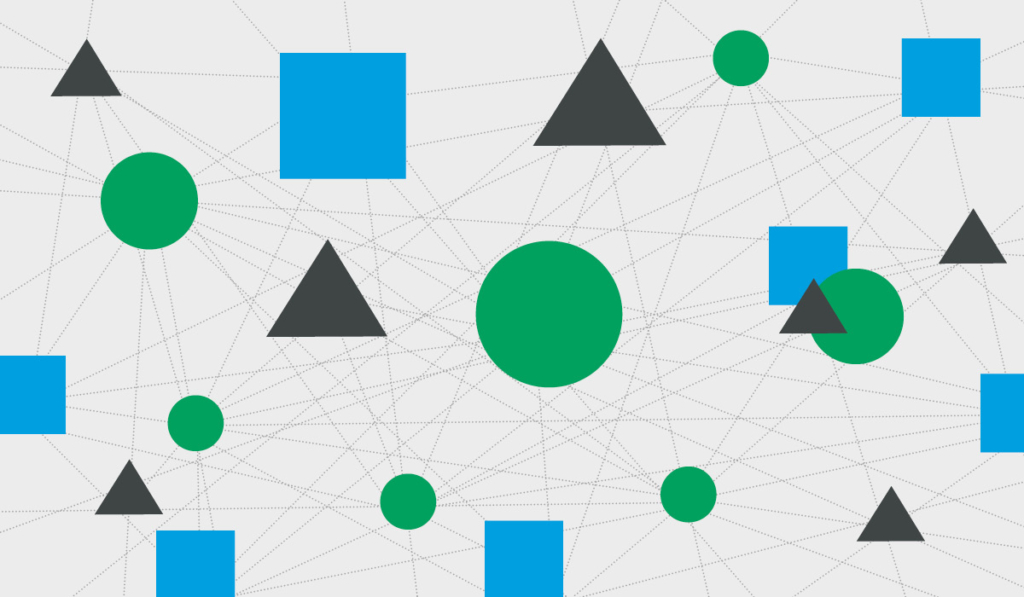Diverse places for learning exist in every community, but the connective tissue making it a vibrant ecosystem do not. We invite you to imagine and create with us and others in your community so that we can bring these ecosystems to life.
Education Reimagined
Perhaps more so than at any time in American history, the education institution has had its legacy structures and systems exposed as inflexible, inadequate, and inequitable. The moment classrooms and cubicles went from schools and office buildings to households, apartments, and shelters, the education system underwent a national audit by families everywhere.
With schools no longer able to operate as usual, families and communities began stepping in to facilitate learning and care for young people in ways that were never imagined in the original blueprints of our education systems. Over the course of only a few weeks and months, we discovered just how many people were ready—out of sheer necessity—to invent something new for their communities.
However, as the pandemic wanes and we are pulled to go back to “normal,” this inventive spirit could quickly go dormant. People are more ready, open, and yearning for a new future than ever before, but without a bigger, transformational vision—one that answers the nationwide call for systems change—for us to set our sights on, we risk this window of opportunity closing.
For real transformation to take hold across an entire system (e.g. not just looking at changing how schools operate or creating a single model or program within the system), we must provide a clear and motivating vision that shows how learning could be organized, supported, and credentialed to meet a fundamentally new purpose for education. One that matches the needs and desires of families and communities such that they can see new possibilities and feel empowered to make them a reality for young people. We believe those new possibilities will take shape within and throughout what we are calling equitable, community-based, learner-centered ecosystems.
A Vision for Vibrant, Inclusive, Community-Based Ecosystems of Learning
The possibility before us is a future in which education is no longer an isolated institution that judges and promotes young people based on comparisons to averages (built to sift and sort kids into century-old categories of expected lifetime achievement).
Rather, the education system becomes the backbone to dynamic, interdependent ecosystems where the community and world are the playgrounds for learning; equity, human dignity, and liberation are fostered; and young people—no matter who they are or where they are from—are supported to thrive and contribute in a complex, fast-changing, and interconnected world.
In this vision of an ecosystem of learning, young people and their families are supported to navigate a vibrant world of learning experiences, make sense of them, identify areas for growth, and see next steps—all in service of developing young people as lifelong learners with the skills and ways of being to provide for themselves and their families and to thrive in life.
Whereas now the standardized education system operates as a rigid institution (populated by incredible, compassionate educators and leaders) that has shown little meaningful change over the past 125 years, in an ecosystem, everything is alive.
Ecosystems offer the possibility that our children’s education could be supported in living systems that are, as Stephanie Pace Marshall articulates, “dynamic living webs of interdependent relationships—inherently whole, abundant, creative and self-organizing.”
Only in this way can they see every child as unique and full of unbounded potential; and support them to narrate their own story of growth and connection to each other, their community, and the world beyond.
This vision of ecosystems of learning may be radically different than what exists today, but it is not radical.
Education Reimagined
As the needs of each young learner, their family, and their community shift, the learning ecosystem can easily shift with it. This type of freedom and flexibility can’t be found within the current system—it simply wasn’t built to provide it. It’s why we call this work transformative and inventive, rather than reformative and innovative.
To reform and innovate means you are iterating on what currently exists. To innovate on the current system and expect never-before-realized outcomes is to expect to make it to the moon by tweaking the design of a car, when in reality we need a rocketship.
This proposed ecosystem for learning (and its enabling supports) is our rocketship. Yes, it will require shifting how we view the roles of adults; when, where, and how we assess and credential learning; how resources are allocated; and what governance and shared accountability structures look like.
But, if we believe children are curious, wondrous, capable, and unique and families want their children to be happy, prepared, and supported to pursue their interests and ambitions, this ecosystem blueprint is one robust example of what we’d want to see within our communities. Now is the time to invent and bring to life this ecosystem of learning that can achieve those desired results.
Before painting a picture of how an ecosystem might operate within a specific community, we will first offer up a handful of foundational components such an ecosystem might use to organize itself. We believe a structure like this will promote a unique fusion between supporting the needs, interests, and aspirations of the individual child and the positive attributes that lead to thriving communities.

In this vision for community-based, learner-centered ecosystems, there are three general spaces for learning—home bases, learning hubs, and field sites:
- Home bases provide the safe space for young people to build stable, years-long relationships with a cohort of peers and one or two adults called learning advisors. Here, they connect with their advisor(s) with whom they partner to set learning goals, create learning pathways, find support, and manage their health and well-being. As will be a theme with each learning space we describe, these home bases could be located just about anywhere in the community, and different ones might cater to specific learner interests, needs, and/or circumstances.
- Learning hubs serve as spaces of deep learning and inquiry, where learning facilitators and learning specialists support young people to develop and demonstrate competencies, pursue topics and issues of interest, get learning support where they are struggling, and engage in virtual opportunities—all in support of fulfilling the child’s learning goals and plans they’ve set with their advisors. Libraries, office buildings, YMCAs, museums, converted school buildings, colleges, community gardens, theaters, churches, and more could all serve as learning hubs—and a child might spend time in various learning hubs throughout the day or week depending on what interest, competency, or pathways they are pursuing at any given time.
- Field sites are the spaces where learners meet and work with community mentors through such opportunities as internships, jobs, field projects, and service learning. The list of possible field sites is nearly endless—banks, pharmacies, retirement homes, nonprofits, graphic design studios, sewage treatment facilities, pet stores, food pantries, to name a few.
Children and young people move through this ecosystem according to their own unique learning journey and in ways appropriate to their development and maturity. This is not an isolated or isolating path; in the context of the ecosystem, young people are finding community and belonging; developing basic human literacies in such areas as mathematics, language, history, and science; exploring their interests and ideas; receiving support and guidance; pushing their thinking; and building their social capital.

Over the course of their time in this ecosystem of learning, they will experience many more opportunities to engage with adults who guide, mentor, support, and champion them than our current systems allows for.
Finally, given the complexity and fluidity of this ecosystem approach, effective coordination that ensures equity, safety, and transparency will be paramount. To name a few major ones, areas of coordination will include:
- Making all of the opportunities visible and navigable by youth, families, and advisors
- Assessment and credentialing of learning
- Accountability, resources, and governance
- Recognizing, supporting, and credentialing adults
- Transportation
This vision of ecosystems of learning may be radically different than what exists today, but it is not radical. It builds on the incredible work that learner-centered practitioners, youth development leaders, and communities have been advancing for decades and their learnings of what it takes to equitably and powerfully serve children and young people who are diverse across every dimension.
This vision is also strongly informed by the wisdom from communities, past and present, who have joined together to raise their children as people who see and know themselves and are committed to making a difference in the world.
Diverse places for learning exist in every community, but the connective tissue making it a vibrant ecosystem do not. We invite you to imagine and create with us and others in your community so that we can bring these ecosystems to life.
To help spark your imagination, we offer this story of a fictionalized learner-centered ecosystem to inspire, provoke, and invite new conversations about what it could look like if learning were embedded and weaved into the contexts, cultures, natural environments, and people within our local and global communities.
Exploring the Power and Potential of Ecosystems in O‘ahu, Hawai‘i
While fictionalized, this story is set in the very real context of O‘ahu, Hawai‘i. Over the last decade, the state has been grappling with what it most wants its education system held accountable for delivering for its children. And, how the wisdom and culture of Hawai‘i can serve as a foundation for that.
As recently as 2020, Hawai‘i’s Board of Education has set out an ambition that by 2030, its education system delivers on a set of promises for every single learner across its seven islands. The promises are made around five themes and six outcomes. The themes include: Hawai‘i-based education, equity, empowerment, design, and innovation. The outcomes include a strengthened sense of: Belonging, Responsibility, Excellence, Aloha, Total Well-Being, and Hawai‘i.
Projected out to 2028, this story imagines what could be if the island of O‘ahu, grounded in these promises, took up the call to create a learner-centered ecosystem that aligns with the island’s unique history, community, and context. In this projected future, each of Hawai‘i’s seven islands share a commitment to transforming their systems through an ecosystems approach.
Although each island is creating a unique ecosystem that matches the needs of their respective communities, they are consistently sharing and learning together—all in a push to invent systems and structures that fully support learners to know who they are, where they come from, and that wherever they want to go, they’ll be supported to do so.

O‘ahu, Hawai‘i 2028
O‘ahu’s ecosystem of learning can best be described as energetic, revitalizing, awakening, and proactive. Gone are the days of walking into a single building where hundreds of young people must remain each day, being delivered the same content at the same pace, and the adults in the building serving as the main source for information. Instead, there are so many learning experiences occurring at such a variety of locations across the island at any given point in time, it would be impossible for any one person to name them all.
While one group of multi-aged learners might be at a field site testing ocean salinity levels with a marine biologist, another group might be at another field site working with The Institute For Human Services to expand their capacity at Hale Mauliola—a temporary housing center for couples and individuals awaiting permanent housing. Meanwhile, a Kumu Hula (an elder and dance teacher) is teaching the traditions of and movements for the Hula Kahiko to another group of children at a learning hub.
And, yet another group still might be at their home base catching up with their advisory family, while their learning advisor does one-on-one check-ins to go over each child’s learning plans and simply see how the learners are doing mentally and emotionally. One young learner had their internship fall through and is working with their advisor to make a new plan to gain experience in the hospitality industry. Another learner recently learned his parents are divorcing and has been struggling. His advisor creates space to talk through how he is handling the change, how he can take care of himself, and how he can use his learning pursuits in the culinary arts as a way to add joy to his day.
Imagine hundreds of other learning experiences like these, as well as virtual opportunities, happening across the island, and you’ll start to sense a brand new way the O‘ahu community relates to what it means to educate young people.
There is no requirement, from one young learner to the next, for how long or how many days per week they might spend in any one place.
Education Reimagined
The number of learning experiences a single young person engages in throughout the day is dependent on their unique learning pathway and learning needs, but the community put a limitation in place that no more than three learning spaces could be visited in a single day. The purpose here was to honor the idea that deeper learning arises in contexts that are multi-disciplinary and where the young person can engage with the experience for multiple hours within a single session.
As a result, young learners have experienced reduced stress levels, feelings of increased focus and intention, and an ability to draw unexpected connections within and across their learning experiences.
The amount of time a learner spends each day at their home base, learning hubs, and field sites is dependent on their unique learning journey. There is no requirement, from one young learner to the next, for how long or how many days per week they might spend in any one place.
What matters are the agreements made between young learners, their families, and their adult mentors (e.g. learning advisors, internship hosts, community liaisons); the competencies each learning experience is helping them develop; and how those learning experiences fit within the themes and promises the Department of Education has in place. This design freedom has led young learners to have a sense of ownership and pride in the trajectory of their learning journeys.
There is no finish line in this work.
Education Reimagined
Behind the scenes, Hawai‘i’s rail and bus systems are organized in ways that learners can get within a safe walking distance of where they want and need to be, which includes travel between home bases, learning hubs, field sites, and residential neighborhoods.
Family support systems are woven into the day-to-day educational experience, including resources for housing, food, and medical services to ensure young people have what they need to access and fully engage in their learning journey.
New policies and financial structures—the creation of which required significant collaboration between policymakers and the broader community—ensure the system is equitable and adaptable to the needs of learners, their families, and the community.
And, the integration of technology has made it easy for the young learner, their advisor, and their family to track learning progress no matter where the child is, who they’re with, or what they are learning throughout the day.
The amount of coordination needed to activate this ecosystem of learning can’t be understated, and the community continues pushing forward to fully realize their bold vision—one focused on an intentional commitment to break the predictive link between a child’s race or zip code and their life outcomes.
In reality, there is no finish line in this work. Hawai‘i’s seven ecosystems are as alive as the natural environments they are built on—flexible and adaptable enough to respond to the unique needs of every child and family. Through constant conversation with the community, lessons and ideas are being shared every day, and action is being taken when new, unexpected opportunities arise.
If you close your eyes and imagine how some of these components might show up in your community, what do you see? What new opportunities, questions, or challenges do you hope to pursue? And, who will you partner with in pursuit of realizing a transformed future for your community?
Want to learn more about community-based ecosystems of learning? Join Learning Out Loud with Education Reimagined—a conversation series focused on grappling with the complexity of what it means to transform the education system to one that is equitable, community-based, and learner-centered. Register here to join upcoming conversations.
